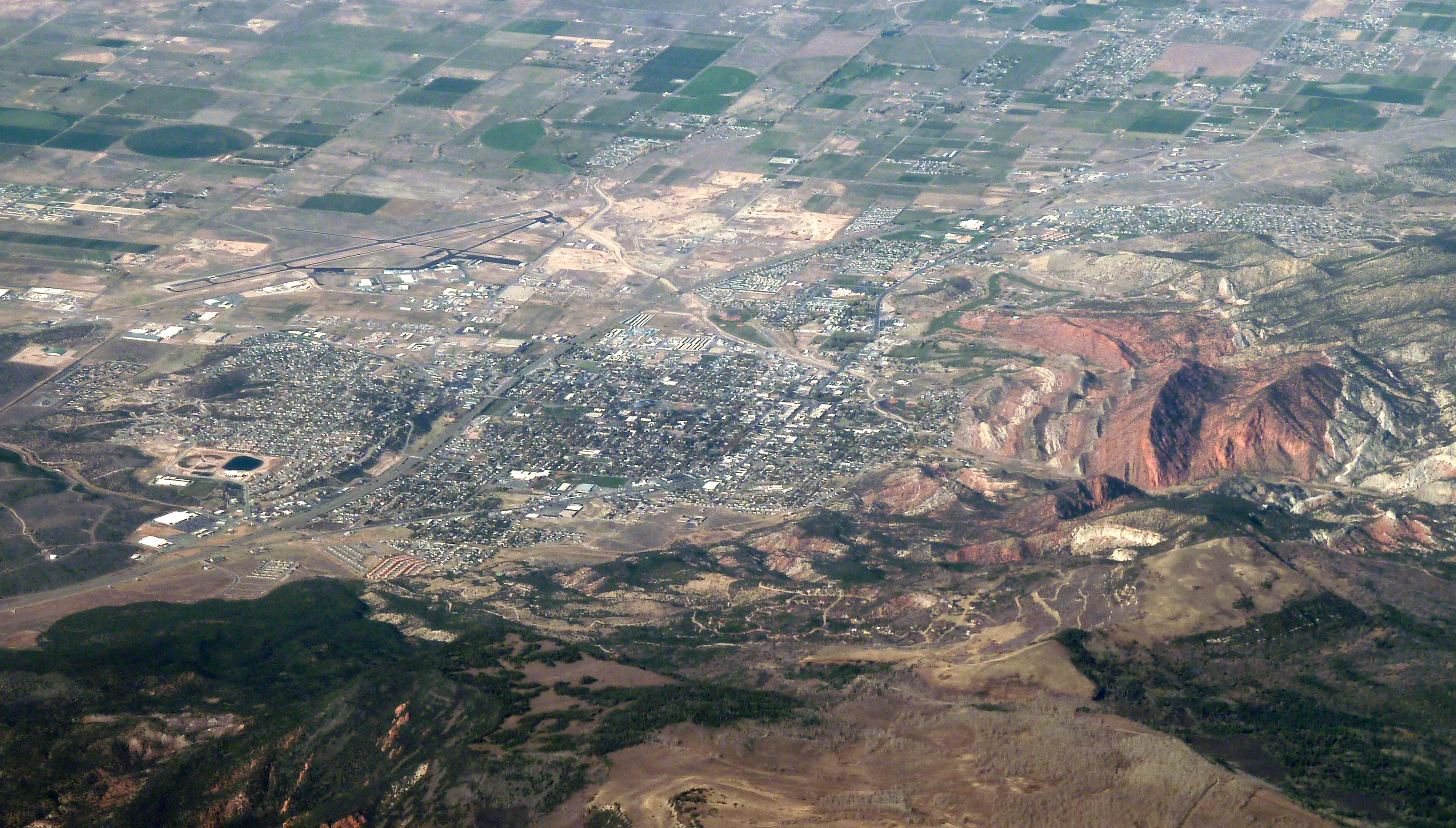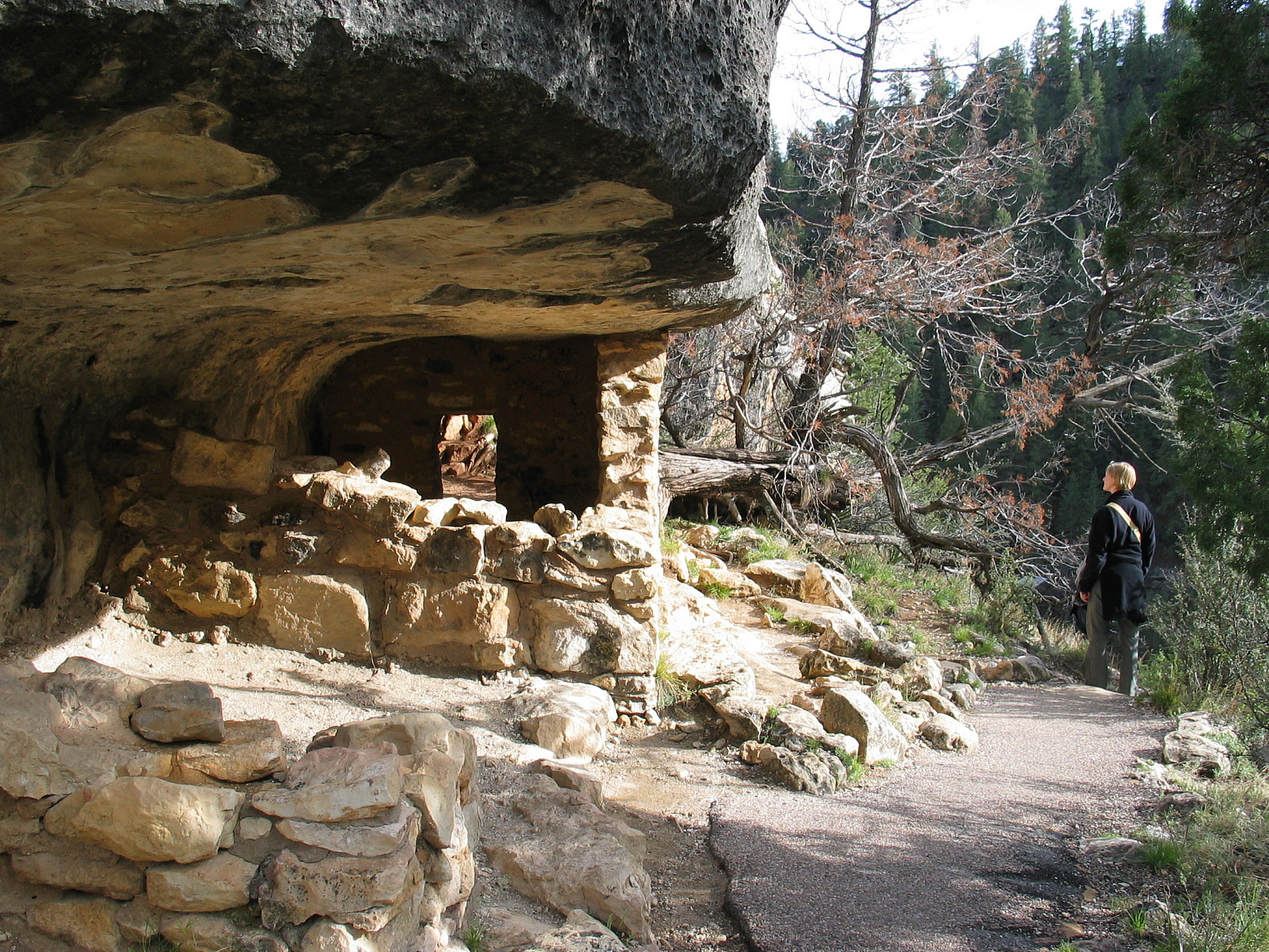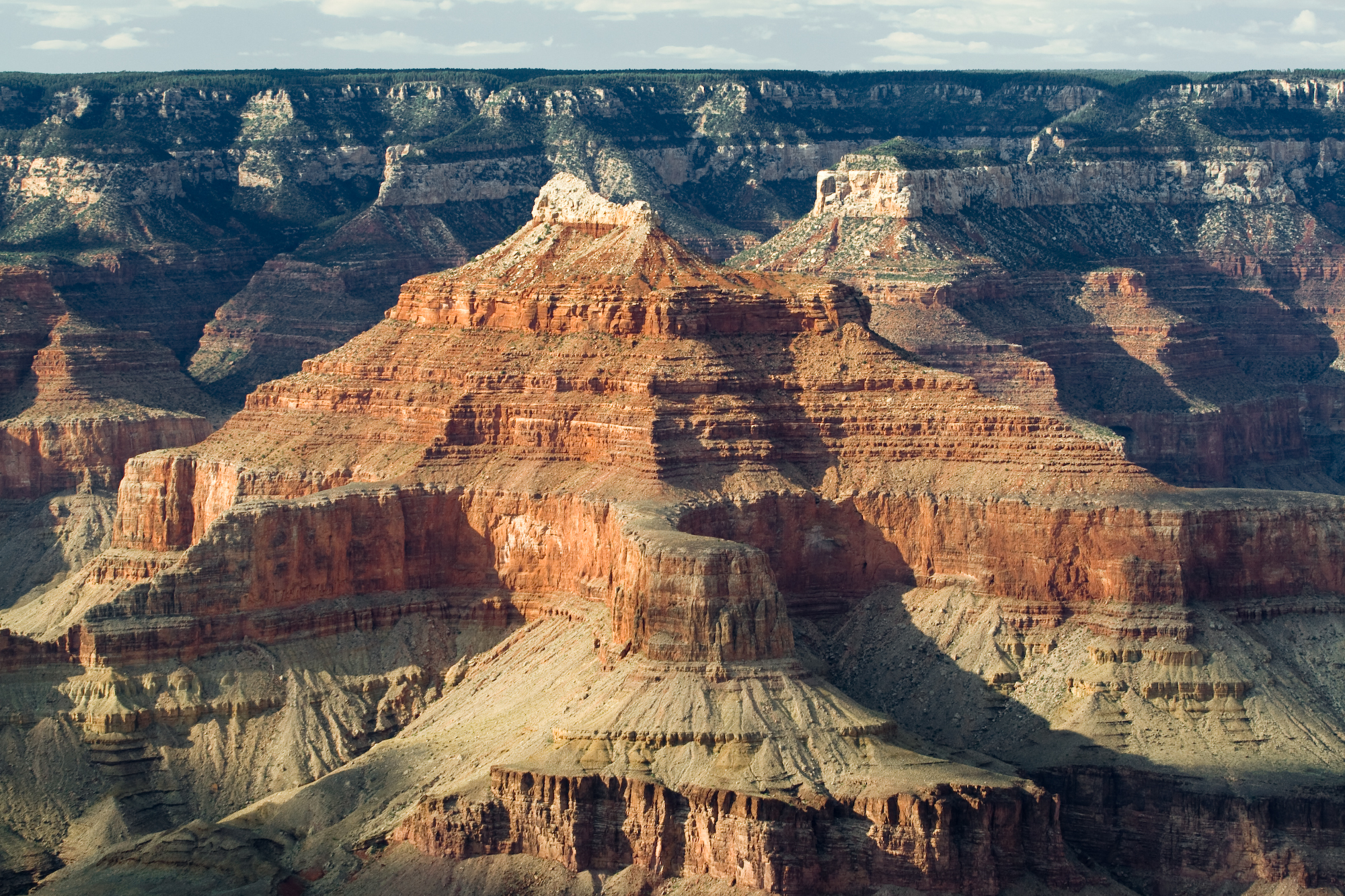|
Toroweap Formation
The Middle Permian Toroweap Formation is a thin, darker geologic unit, between the brighter colored units of the Kaibab Limestone above, and Coconino Sandstone below. It is a prominent unit in Grand Canyon, Arizona, USA, found through sections of the South Rim, Grand Canyon, and the North Rim, of the Kaibab Plateau; also the Kaibab's southeast extension to Cape Royal, the Walhalla Plateau. The Colorado River of the Grand Canyon makes its excursion from due-south to due-west around the Walhalla Plateau, as it enters the east end of the Grand Canyon's interior, Granite Gorge. The formation is also found in southeast Utah. The Toroweap Formation is a darker unit of gypsum and shale; also sandstone. In photos the '' cliff-forming'' Kaibab and Coconino units, show the more erodable Toroweap Formation '' slope-forming'' accumulations upon the underlying Coconino Sandstone; likewise below the Coconino, the softer Hermit Formation is shown forming slopes, above the slope forming 're ... [...More Info...] [...Related Items...] OR: [Wikipedia] [Google] [Baidu] |
Permian
The Permian ( ) is a geologic period and stratigraphic system which spans 47 million years from the end of the Carboniferous Period million years ago (Mya), to the beginning of the Triassic Period 251.9 Mya. It is the last period of the Paleozoic Era; the following Triassic Period belongs to the Mesozoic Era. The concept of the Permian was introduced in 1841 by geologist Sir Roderick Murchison, who named it after the region of Perm in Russia. The Permian witnessed the diversification of the two groups of amniotes, the synapsids and the sauropsids ( reptiles). The world at the time was dominated by the supercontinent Pangaea, which had formed due to the collision of Euramerica and Gondwana during the Carboniferous. Pangaea was surrounded by the superocean Panthalassa. The Carboniferous rainforest collapse left behind vast regions of desert within the continental interior. Amniotes, which could better cope with these drier conditions, rose to dominance in place of their am ... [...More Info...] [...Related Items...] OR: [Wikipedia] [Google] [Baidu] |
Colorado River
The Colorado River ( es, Río Colorado) is one of the principal rivers (along with the Rio Grande) in the Southwestern United States and northern Mexico. The river drains an expansive, arid drainage basin, watershed that encompasses parts of seven U.S. states and two Mexican states. The name Colorado derives from the Spanish language for "colored reddish" due to its heavy silt load. Starting in the central Rocky Mountains of Colorado, it flows generally southwest across the Colorado Plateau and through the Grand Canyon before reaching Lake Mead on the Arizona–Nevada border, where it turns south toward the Mexico–United States border, international border. After entering Mexico, the Colorado approaches the mostly dry Colorado River Delta at the tip of the Gulf of California between Baja California and Sonora. Known for its dramatic canyons, whitewater rapids, and eleven National parks of the United States, U.S. National Parks, the Colorado River and its tributaries are a v ... [...More Info...] [...Related Items...] OR: [Wikipedia] [Google] [Baidu] |
Hurricane Cliffs
The Hurricane Cliffs of southwest Utah and northwest Arizona are a red, limestone geographic feature, sets of cliffs along the western, eroded edge of the Kaibab Limestone; the cliffs are about 135-mi (217 km) long,''Utah Atlas & Gazeteer,'' DeLorme, 9th Ed. 2014 pp. 49, 50, 57 with the south end terminus just north of the Grand Canyon. The cliffs are associated with the Hurricane Fault. Description The Hurricane Cliffs are part of the landforms on the southwest perimeter of the Colorado Plateau, specifically the '' High Plateaus section''; the High Plateaus are transitional to the Great Basin northwest, the Mojave Desert west, and the Arizona transition zone, southwest and south of the Coconino Plateau. From Arizona, the cliffs trend north into Utah, but north of Hurricane, at Anderson Junction and Pintura, the trendline turns north-northeast, and by Cedar City, Cedar Valley, Summit, and the Parowan Valley, the trend is northeast. At the northeast end of Parowan V ... [...More Info...] [...Related Items...] OR: [Wikipedia] [Google] [Baidu] |
Hurricane Fault
The Hurricane Fault is an intracrustal seismic fault that runs along the boundary between the Colorado Plateau block and the Basin and Range geologic province of western North America. It is a 250-km-long, north-south striking, high-angle, down-to-the-west normal fault, running from about Cedar City, Utah southward into northwestern Arizona. The fault is named for the community of Hurricane A tropical cyclone is a rapidly rotating storm system characterized by a low-pressure center, a closed low-level atmospheric circulation, strong winds, and a spiral arrangement of thunderstorms that produce heavy rain and squalls. Depend .... The 1992 St. George earthquake (magnitude 5.8), which triggered a damaging landslide, has been attributed to the Hurricane Fault. References Structural geology Geology of Utah {{US-geology-stub ... [...More Info...] [...Related Items...] OR: [Wikipedia] [Google] [Baidu] |
Toroweap Fault
The Toroweap Fault of northwest Arizona and southwest Utah is part of a fault system of the west Grand Canyon region, Arizona, US; also the west perimeter regions of the Coconino and Colorado Plateaus. The Hurricane Fault originates at the Toroweap Fault, in the region of the Colorado River, and strikes as the westerly depression of the Toroweap Fault. The Toroweap strikes northerly from the Colorado at the east of Toroweap Valley, and enters south Utah; from the Colorado River, the Hurricane Fault strikes north-northwest along the west flank of the small, regional Uinkaret Mountains, the west border of Toroweap Valley. The Hurricane Fault, and the Hurricane Cliffs strike into southwest Utah as part of the west, and southwest perimeter of the Colorado Plateau. The Hurricane Cliffs are made of Kaibab Limestone, an erosion resistant, '' cliff-forming'' rock unit. The Uinkaret volcanic field is a resultant of the two-fault system, at the intersection region. Two example landfor ... [...More Info...] [...Related Items...] OR: [Wikipedia] [Google] [Baidu] |
Toroweap Sunrise
Toroweap Overlook (also known as Tuweep Overlook or Toroweap Point) is a viewpoint within the Grand Canyon National Park in Arizona, United States. It is located in a remote area on the North Rim of the Grand Canyon, west of the North Rim Headquarters (but by road). The overlook is the only viewpoint in the National Park from where the Colorado River can be seen vertically below. The overlook stands above the river. Terminology Toroweap and Tuweep are used more or less interchangeably. The term Tuweep, a Paiute word for "the earth", was used for an early Mormon settlement in the valley, and is now used by the National Park Service to refer to the area. Toroweap, a Paiute term meaning "dry or barren valley", strictly refers to the valley and the overlook. Geology At Toroweap the layer of soft Hermit Shale is about 800 feet thick, much thicker than farther east. Erosion of this layer formed the broad Esplanade Platform on the resistant Esplanade Sandstone. Further e ... [...More Info...] [...Related Items...] OR: [Wikipedia] [Google] [Baidu] |
Siltstone
Siltstone, also known as aleurolite, is a clastic sedimentary rock that is composed mostly of silt. It is a form of mudrock with a low clay mineral content, which can be distinguished from shale by its lack of fissility.Blatt ''et al.'' 1980, pp.381-382 Although its permeability and porosity is relatively low, siltstone is sometimes a tight gas reservoir rock, an unconventional reservoir for natural gas that requires hydraulic fracturing for economic gas production. Siltstone was prized in ancient Egypt for manufacturing statuary and cosmetic palettes. The siltstone quarried at Wadi Hammamat was a hard, fine-grained siltstone that resisted flaking and was almost ideal for such uses. Description There is not complete agreement on the definition of siltstone. One definition is that siltstone is mudrock ( clastic sedimentary rock containing at least 50% clay and silt) in which at least 2/3 of the clay and silt fraction is composed of silt-sized particles. Silt is defined a ... [...More Info...] [...Related Items...] OR: [Wikipedia] [Google] [Baidu] |
Marine Transgression
A marine transgression is a geologic event during which sea level rises relative to the land and the shoreline moves toward higher ground, which results in flooding. Transgressions can be caused by the land sinking or by the ocean basins filling with water or decreasing in capacity. Transgressions and regressions may be caused by tectonic events such as orogenies, severe climate change such as ice ages or isostatic adjustments following removal of ice or sediment load. During the Cretaceous, seafloor spreading created a relatively shallow Atlantic basin at the expense of deeper Pacific basin. That reduced the world's ocean basin capacity and caused a rise in sea level worldwide. As a result of the sea level rise, the oceans transgressed completely across the central portion of North America and created the Western Interior Seaway from the Gulf of Mexico to the Arctic Ocean. The opposite of transgression is regression in which the sea level falls relative to the land and expo ... [...More Info...] [...Related Items...] OR: [Wikipedia] [Google] [Baidu] |
Flagstaff, Arizona
Flagstaff ( ) is a city in, and the county seat of, Coconino County, Arizona, Coconino County in northern Arizona, in the southwestern United States. In 2019, the city's estimated population was 75,038. Flagstaff's combined metropolitan area has an estimated population of 139,097. Flagstaff lies near the southwestern edge of the Colorado Plateau and within the San Francisco volcanic field, along the western side of the largest contiguous Pinus ponderosa, ponderosa pine forest in the continental United States. The city sits at about and is next to Mount Elden, just south of the San Francisco Peaks, the highest mountain range in the state of Arizona. Humphreys Peak, the highest point in Arizona at , is about north of Flagstaff in Kachina Peaks WildernessThe geology of the Flagstaff areaincludes abundant volcanic rocks associated with the San Francisco Volcanic Field that range in age from late Miocene to late Holocene. It also includes exposed rock from the Mesozoic and Paleozoic ... [...More Info...] [...Related Items...] OR: [Wikipedia] [Google] [Baidu] |
Walnut Canyon National Monument
Walnut Canyon National Monument (Hopi: Wupatupqa) is a United States National Monument located about southeast of downtown Flagstaff, Arizona, near Interstate 40. The canyon rim elevation is ; the canyon's floor is 350 ft lower. A long loop trail descends into the canyon passing 25 cliff dwelling rooms constructed by the Sinagua, a pre-Columbian cultural group that lived in Walnut Canyon from about 1100 to 1250 AD. Other contemporary habitations of the Sinagua people are preserved in the nearby Tuzigoot and Montezuma Castle national monuments. History Sinagua is Spanish for "without water", an acknowledgement that the Sinagua people were able to live in such a dry region. By living in such a region the Sinagua became experts at conserving water and dealing with droughts. The Sinagua were also believed to have been active traders whose activities and influence stretched to the Gulf of Mexico and even as far as Central America. The Sinagua, who inhabited the dwellings ... [...More Info...] [...Related Items...] OR: [Wikipedia] [Google] [Baidu] |
Supai Group
The Supai Group is a slope-forming section of red bed deposits found in the Colorado Plateau. The group was laid down during the Pennsylvanian to Lower Permian. Cliff-forming interbeds of sandstone are noticeable throughout the group. The Supai Group is especially exposed throughout the Grand Canyon in northwest Arizona, as well as local regions of southwest Utah, such as the Virgin River valley region. It occurs in Arizona at Chino Point, Sycamore Canyon, and famously at Sedona as parts of Oak Creek Canyon. In the Sedona region, it is overlain by the Hermit Formation, and the colorful Schnebly Hill Formation. The Supai Group is coeval with the Hermosa Group of east and south Utah; the Hermosa Group extended southeastwards from Utah to Durango, extreme southwest Colorado, and adjacent to the Hermosa type section. The Supai Group was originally designated as the Supai Formation by N.H. Darton in 1910 for exposures at Supai, Arizona. It was first raised to group stratigrap ... [...More Info...] [...Related Items...] OR: [Wikipedia] [Google] [Baidu] |
Hermit Formation
The Permian Hermit Formation, also known as the Hermit Shale, is a nonresistant unit that is composed of slope-forming reddish brown siltstone, mudstone, and very fine-grained sandstone. Within the Grand Canyon region, the upper part of the Hermit Formation contains red and white, massive, calcareous sandstone and siltstone beds that exhibit low-angle cross-bedding. Beds of dark red crumbly siltstone fill shallow paleochannels that are quite common in this formation. The siltstone beds often contain poorly preserved plant fossils. The Hermit Formation varies in thickness from about in the eastern part of the Grand Canyon region to about in the region of Toroweap and Shivwits Plateaus. In the Sedona, Arizona area, it averages in thickness. The upper contact of the Hermit Formation is typically sharp and lacks gradation of any kind. The lower contact is a disconformity characterized by a significant amount of erosional relief, including paleovalleys as much as deep. See ... [...More Info...] [...Related Items...] OR: [Wikipedia] [Google] [Baidu] |




.jpg)



